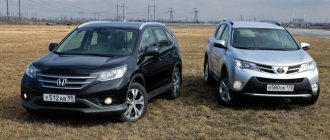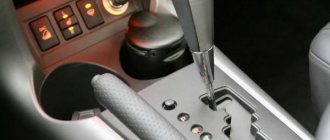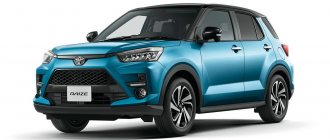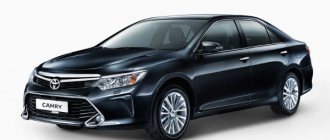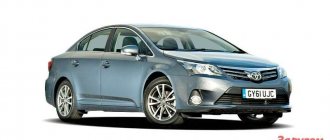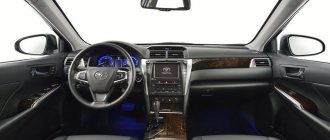With a budget of about 1.5-2 million rubles, you can safely count on buying an excellent car from one of the leading manufacturers. It’s definitely not worth chasing premium brands. Here the emphasis is on reliability, efficiency and practicality. The optimal choice for many city residents who periodically travel outside the populated area is increasingly becoming a crossover. Some people prefer a compact SUV, while others choose mid-size models.
The South Korean Kia Sportage and the Japanese Toyota RAV4 can easily be considered among the most popular and objectively best cars in this segment.
General technical information
To compare the Kia Sportage and Toyota RAV4, it’s worth taking a look at their technical characteristics, appearance, and interior organization. This will allow us to draw certain conclusions about the practicality, efficiency and feasibility of purchasing a particular SUV option.
At the end of 2021, the world premiere of the new generation RAV4 produced by Toyota took place. But the new product will reach Russian consumers only by the end of 2021. This will immediately be a Japanese crossover of domestic assembly. In the meantime, the 4th generation remains relevant.
A restyled version of the 2016 model year is currently on sale. Externally, it was transformed compared to the pre-restyling version, received new equipment and an updated interior.
Toyota RAV4 is built on the Toyota MC platform with a monocoque body and a transverse engine. The suspension is fully independent with MacPherson struts at the front and a multi-link system at the rear. Already in the base, the steering comes with electric power steering. All brakes are disc, front ventilated. ABS, EBD and BAS systems are standard. Front-wheel drive or plug-in all-wheel drive.
The 4th generation Kia Sportage, still relevant today, was shown in 2015. To create the South Korean crossover, they used a modernized platform from its predecessor. Like the RAV4, the suspension is fully independent with a multi-link design at the rear and MacPherson struts at the front. The rack and pinion steering mechanism is complemented by an electric booster. The front brakes, like the rear ones, are disc, but also have ventilation. ABS, EBD and BAS systems are installed as standard. Front-wheel drive or plug-in all-wheel drive.
Kia Sportage
In technical terms, the cars are very similar to each other. Therefore, they need to be compared according to other parameters in order to determine the favorite.
Appearance
As you already understand, the design of both models turned out to be controversial. In 2012, a new generation of Toyota Rav 4 was released, whose appearance was met extremely negatively. 3 years later, the Japanese company presented the world with a redesigned version of its crossover. The bugs were corrected, but the “taste” from the previous body remained. Therefore, it took some time to get used to the updated appearance.
But in general, the car acquired a more aggressive look, which was created by narrowed headlights and a false grille with an enlarged logo, as well as a massive bumper with pointed air intakes.
There are still complaints about the design of the stern and the separate rear door. However, compared to the dubious 2012 body, restyling has taken a step forward.
With the Kia Sportage the situation is exactly the opposite. It was the stern and profile of the car that turned out to be impeccable. At the rear, narrowed headlights with LED lines were installed, shaped like the optics of the BMW i8.
Together, all the rear and side details create an exceptionally sporty appearance that looks attractive and complete.
But the “face” of the car makes me perplexed. How can sporty graceful profiles be combined with what happened in front.
The headlights are too convex and rounded to fit into the aggressive image, and the radiator grille even resembles a monster's mouth.
And this is not being picky. The little things are extremely important because they create the image and visual perception of the car, and these, in turn, directly affect the number of sales.
In fairness, it is worth noting that some people liked the new Kia design, as well as the appearance of the Rav 4 2012-2013. But this is rather an exception to the rule.
Exterior
It’s worth starting with the most subjective criterion. When choosing between a Toyota RAV4 or a Kia Sportage, many initially look at the appearance.
The exterior of the Japanese crossover looks quite solid and moderately modern. Although some note rather simple solutions and a prominent rear massive stern.
Kia Sportage received a signature radiator grille, rather swift body lines, and optimal proportions.
Each car is beautiful and interesting in its own way. Everyone has different tastes, and therefore it is impossible to talk about the visual superiority of one crossover over another. The consumer will judge the appearance based on his preferences.
But it is important to say about the external dimensions. Although the RAV4 is a compact crossover, its dimensions are on the verge of falling into the midsize segment:
- length 4605 mm;
- height 1670 mm;
- width 1845 mm;
- wheelbase 2660 mm;
- ground clearance 197 mm.
But you won’t be able to make a claim to go beyond the boundaries of its class with the 4th generation Kia Sportage. Everything here is quite expected:
- length 4480 mm;
- height 1635 mm;
- width 1855 mm;
- wheelbase 2670 mm;
- ground clearance 182 mm.
Kia Sportage salon
With the larger size of the Japanese, the Korean even surpasses its opponent in wheelbase. But Kia's ground clearance is standard, which may affect cross-country ability.
Exterior of Toyota Rav 4 and Kia Sportage
Toyota Rav 4 contains elements taken from previous generations, or rather it is noticeable in profile. The remaining parts were redone: replacing smooth outlines with unusual edges, individually shaped lighting equipment in the front and a powerful rear part. From the usual - only a front bumper and stylish LED headlights.
As for the Kia Sportage, it is popular for its stylish appearance in a variety of colors. This generation has changed a little, but not very much. The shape and outline of the body are the same, but the designers worked on the rest. In general, the appearance of the Korean is very, very presentable.
Interior and luggage compartment
It is also worth comparing two crossovers from Japan and South Korea in terms of interior decoration and interior organization.
The 4th generation Sportage's interior is in many ways reminiscent of the flagship South Korean SUV Sorento Prime. Stylish and expensive appearance, the dashboard is slightly turned towards the driver, and a modern multifunction steering wheel. The new generation Sportage has managed to increase interior space. As a result, it became much more comfortable for tall passengers. There is more space in the legs and above the head. The sofas are comfortable, with a pronounced profile. The finishing materials are also of good quality. The advantages include improved sound insulation. How comfortable it will be for 3 adult passengers in the back is a moot point. Maximum comfort is available for 2. But the low central tunnel allows you to sit quite comfortably in the middle.
The luggage compartment has a capacity of 503 liters without a spare wheel. If you add it to the package, the trunk will decrease to 491 liters. The wide hold and low loading height made loading and unloading more convenient.
The RAV4 has interior features of Lexus crossovers, which is quite logical. The interior looks fresh, modern and attractive. It is immediately clear that this is a car of the 21st century. There are no complaints about the finishing materials. The salon is designed for 5 people, including the driver. The front seats offer pronounced lateral support and many adjustments. At the rear sofa, you can change the angle of the backrest. There is plenty of space in all directions. Three people can sit together, but true pleasure can only be enjoyed by two people.
The trunk holds 506 liters. And this is taking into account the presence of a partial-size spare tire under the raised floor. The rear bench folds down, just like in the Sportage, to more than triple the space.
So far, absolute equality. The two cars are worthy of each other, and it is impossible to determine an obvious favorite.
Motors, gearboxes and their capabilities
Determining who is better - the South Korean Kia Sportage or the Japanese Toyota RAV4 will largely be helped by comparing technical parameters.
Toyota RAV4
For the current 4th generation RAV4, 3 engines, 3 gearboxes and 2 drive options are available.
- The base 2.0-liter 4-cylinder engine produces 146 hp. Runs on gasoline. Combined with a 6-speed manual transmission or a continuously variable transmission. Front-wheel drive or all-wheel drive. It accelerates from zero to hundreds in 10.2-11.3 seconds. Average consumption is 7.4-7.8 liters per 100 km.
- The top-end gasoline engine has a volume of 2.5 liters and output of 180 horsepower. Accelerates to hundreds in 9.4 seconds. Comes only with all-wheel drive and 6-automatic transmission. Consumption per 100 km. will average 8.6 liters.
- The 2.2-liter diesel version with a turbine generates 150 horsepower. Comes only with automatic transmission and all-wheel drive. It goes from zero to hundreds in 10 seconds, consuming an average of 6.7 liters of diesel fuel.
The Kia Sportage also has 3 engines, 2 of which are petrol and one more diesel.
- The base version is 2.0 MPI with 150 horsepower. It is equipped with an automatic or 6-speed manual transmission. Front-wheel drive or all-wheel drive. Average consumption is 7.8-8.3 liters per hundred. The crossover accelerates to 100 km/h in 10.5-11.6 seconds.
- Next comes a 4-cylinder 1.6-liter gasoline turbo engine with 177 horsepower. Can only be combined with all-wheel drive and a 7-speed automatic transmission. Requires 7.5 liters per 100 km. ways. It can accelerate to hundreds in 9.1 seconds.
- The top-end 2.0-liter turbodiesel engine produces 185 hp. Comes only with all-wheel drive and a 6-speed automatic. Acceleration takes 9.5 seconds. up to hundreds, but the average consumption is about 6.3 liters in the combined cycle.
And again, none of the crossovers have a clear superiority. Although Kia is somewhat more dynamic, and there are no problems with fuel consumption. Yes, the new generation RAV4 will surpass these figures, but for now the Sportage is a little ahead.
An intermediate comparison makes it clear once again that the Kia Sportage and Toyota RAV4 are equal and worthy rivals.
Toyota Rav 4 - Kia Sportage - comparison
Under the hood of the Toyota RAV4 there is a 2-liter naturally aspirated engine with a power of 149 hp. The main feature of the transmission was a variator with a mechanical first gear and all-wheel drive. This copy is estimated at 2,290,000 rubles. The rival will be the Kia Sportage with a 2-liter engine producing 150 hp. Transmission: all-wheel drive, hydromechanical. The test car will cost RUB 1,929,900.
We sit in the front
Toyota Rav 4 is distinguished by a single stylistic solution, which is recognizable in every detail of the interior. Wireless charging of mobile phones, multi-position seat adjustment. In the new car, the designers of the Japanese concern tried to maximize the visibility for the driver.
A modern, digital cabin with large screens and tactile delights. All handles have the same notch, even where you can only check it by touch Well-drawn, clear instrument cluster Familiar layout, a big plus in modern design To improve visibility, they added a small glass triangle and moved the side mirror to the side surface of the door Rarely pleasant handles, like by touch and by rotation force. The same notch can be felt on the inner surfaces of the door handles. Wireless charging is not only functional, but also with a good design.
To do this, practically bit by bit, the same visibility was squeezed out of every detail. We lowered the edge of the hood and made the initial position of the windshield wiper blades lower. The A-pillars became narrower, the side mirror was moved to the door panel, and the plastic insert was replaced with glass. You say it's nonsense? Perhaps, however, all these nuances are felt from the point of view of appearance. However, at the same time... we saved on the illumination of the power window buttons.
Kia Sportage is presented as standard. The interior does not attract anything, and is not much different from the pre-restyling version.
Nice, slightly outdated design. In general, everything is good and to the point The combination fits well into the overall style without causing irritation Electric handbrake is already a common thing today All buttons are push-type Small screen, but considering the overall cost of the car - worthy
We agreed that Toyota's design will still meet the spirit of the times in 5 years. Then, like the Kia Sportage, alas, it is already outdated. So, in the first test, the RAV4 has a clear victory.
Score 1:0
Rear sofa
The amenities for rear row passengers are comparable: climate control, USB, heated seats - a completely standard set of modern cars.
Toyota Rav 4 There are two USB connectors
None of the opponents clearly distinguished themselves.
Kia Sportage Only cigarette lighter available
Therefore, the score for the back row is a draw; let’s add one point to each car.
Score 2:1
Luggage racks
The trunk volume of the RAV 4 turned out to be 114 liters more - 580 liters, versus 466 liters for the Sportage.
It is possible to lower the floor lower. You can turn the panel over, making the floor either non-marking or non-slippery. The choice is up to the owner Hard floor, no other frills
Toyota also has an electric door drive, but the opening speed is not impressive. Well, a very slow mechanism. However, there are practical solutions: the boot floor allows you to lay it on the fleecy or smooth side. For some this may seem like a small thing, but summer residents will appreciate this opportunity. For greater volume, practicality and comfort, a point goes to the Japanese piggy bank.
Score 3:1
Ground clearance
Our obstacle, a tire, rises 200 mm above the asphalt. The Sportage's ground clearance is 190 mm, however, in our experience, this figure does not mean a definite failure. Having touched the protection, the Korean released it from under the rear bumper.
He overcame the obstacle by barely touching it.
We complicate the task - we put three large men back and repeat the experiment. And again the test - now the contact was from behind, but the tire remained in place.
A Japanese car approaches the projectile: with 19-inch wheels, the ground clearance is 200 mm.
The declared ground clearance is higher than that of the Sportage, it has overcome the obstacle
The car passes over the obstacle, lightly touching it with its protection. We load passengers and go for the second lap: there are more sounds, but the tire remains motionless. The result is a draw.
Score 4:2
Rollers
Both cars are all-wheel drive, the rollers are mounted diagonally. The Sportage is the first to pass the test, almost without turning the wheels on rollers, it slides off. Rav 4, without making you worry or wait, leaves the videos at almost the same time.
Easily left the rollers A fraction of a second longer to leave the obstacle
A good, solid draw. I would like to note: the Korean has only one lock button, while the Japanese has the ability to select a mode - it has two clutches.
Score 5:3
Start from a place.
The length of our test area does not allow us to measure acceleration to 100 km/h. We accelerate to about 70 km/h, the parallel start was won by the Korean. We made several starts, but every time it was Sportage who was ahead.
If you look closely, you can see that the Rav 4 is 40 centimeters behind. However, by the end of the distance the difference will be much more noticeable
One could attribute this problem to a brooding CVT. However, the Direct Shift gearbox, a CVT with a manual first gear, promises to eliminate sluggish starts. However, the fact of the Korean's agility was captured on video. Kia wins the dynamic test. Watch the video for all the subtleties and nuances of the races.
Score 5:4
Circle
Our small asphalt track does not have long straights. Therefore, it is not the horsepower that is tested, but the engine-transmission combination.
Toyota is less rolly, and the suspension is tenacious. In moments of strong rolls, the electronics intervene, preventing the car from accelerating. However, this did not stop Sportage from winning this race.
Here the Sportage's lap time was better. With all its fancy electronics, Toyota was powerless against the classic 2-liter engine and automatic transmission. Surprising but true! So, victory for Kia.
Score 5:5
Springboard
The decisive test: the behavior of the car after landing from a small 20 centimeter springboard. We regularly receive negative comments about this. I would like to note: there is a risk of running into such a springboard on the road. We jump in order to evaluate the behavior of the car in such a situation.
Go! Sportage is the first to enter the springboard.
Center of gravity shifted forward
During the flight, the Korean tried to lower his nose, and after landing, his rear wheels just barely lifted off the asphalt. However, the test driver did not feel this; an impartial camera mounted on the car body helped.
RAV 4 performed the trick with 5 points: impeccable landing technique, no bounces - victory for the Japanese.
Excellent weight distribution and clear landing
You can learn more about jumping from the video at the end of the article.
Score 6:5
Results:
Toyota Rav 4 won against Kia Sportage, the gap in the score is minimal, but the difference in price is very large. Modern Toyota, both in design and technical solutions, could not break away from the middle-aged Sportage.
Of course, new interiors and digital delights brought the Rav 4 ahead. However, Sportage is breathing down his neck and after restyling it will overtake the winner
The Korean is more down-to-earth, without designer frills, but noticeably cheaper. Considering the possible imminent release of the updated car, Toyota has something to think about. After all, the competitive world is very tough.
Price policy:
The basic Rav 4 starts at 1.756 million. For this amount, the car will have a 2-liter engine and front-wheel drive. You can purchase an all-wheel drive car by paying a little more than 500 thousand. Under the hood there will be the same naturally aspirated 2.0. However, 18-inch wheels, dual-zone climate control, a rain sensor, parking sensors and an 8-inch multimedia system will appear. Our car: all-wheel drive, 2-liter, on 19-inch wheels. With a 7-inch screen in the instrument cluster and an active control system, it is estimated at 2.3 million. The top version with a 2.5-liter engine, 8-speed automatic transmission and all-wheel drive will cost 2.66 million. Also, this version will include Toyota Safety Sense package of active safety systems.
The Sportage will cost the buyer 1.4 million, for which money he will receive a 2-liter 150 horsepower engine, manual transmission and front-wheel drive. You will have to pay an extra 120 thousand for the machine; the machine will come with “warm options”. By paying an additional 40 thousand, we get all-wheel drive, however, we refuse the automatic transmission. The test “Sportage Prestige” 2-liter, automatic, all-wheel drive is estimated by the manufacturer at 1.929 million. By paying an additional 110 thousand, we get a 2.4-liter, 184 hp. motor. For the premium version, all-wheel drive, 2.4-liter engine and automatic in the cabin, they will announce 2.28 million.
I repeat the video test below, technical specifications at the end of the article
Passability and controllability
Now you can determine which is better between the Toyota RAV4 and Kia Sportage crossovers by looking at their capabilities on and off the road.
In both cases we are talking about urban compact SUVs. At the same time, Toyota has noticeably more ground clearance. Plus, the body configuration adapts the car a little better to trips outside the asphalt. You shouldn't expect excellent all-terrain capabilities, but the RAV4's off-road capability is slightly better than the Sportage's.
Handling in the case of a Korean crossover evokes pleasant emotions. The car is quite low, with good aerodynamics. It behaves confidently at high speed, the electric booster operates clearly and without delay. When cornering, there is almost no roll felt. Approximately the same sensations are observed on the RAV4, but still the Toyota seems heavier. But this is a relative superiority, since traditionally for the Japanese brand their SUV is obedient, maneuverable and stable.
Toyota RAV4 interior
If you are a fan of measured driving and don’t like to press the gas unnecessarily and take sharp turns, both crossovers will definitely suit you. At the same time, the off-road characteristics of the Japanese SUV are slightly better. But for Kia there is a special GT Line package with sportier suspension parameters.
Control and dynamics
The RAV 4 of 2012-2013 had a stiffer suspension. In the restyled version, the power plant has been improved, due to which the car overcomes bumps more smoothly. At the same time, the crossover shows good dynamics. The engine accelerates best in “Sport” mode. The car corners clearly, but the steering can hardly be called soft.
In the new generation Sportage 2021, the control wheel is also tight. At the same time, the steering wheel is less informative, which affects the feeling of the car’s behavior on the road. The Korean has an automatic transmission without any complaints, which does not interfere with the rapid acceleration of the crossover. The car also shows the greatest agility in the “Sport” mode.
If we compare which is more reliable, Rav 4 and Sportage (2009-2010 versions), we can say that both cars show good performance on the road. Each time, manufacturers improve the restyled versions, making them more dynamic.
Security and electronic assistants
There is no significant difference between the installed security systems. In the basic configuration of the two crossovers you can already see ABS, EBD and BAS.
In addition, from the start, the Toyota RAV4 boasts a hill start assist system, TRC, VSC, EBS and TSC. And there will be 7 airbags at once.
The Kia Sportage's basic equipment is somewhat simpler; a number of electronic assistants are missing, and they appear in the top versions. And in terms of the number of airbags, it was not possible to get ahead of the competitor or even equal it. There are 6 of them. Not at all as little, but less than the RAV4. But ABS is paired with ESC.
Yes, in terms of equipment with electronic assistants, the Kia Sportage is slightly inferior to the more advanced RAV4 crossover from Toyota. But here we should not forget about the difference in the starting cost.
If you compare both cars, the 2021 Kia Sportage, like the Toyota RAV4, belongs to the category of modern SUVs with a wide range of safety systems and electronic assistants. Kia is a little inferior, but this is far from critical. The absence of some of the systems available on the RAV4 but not offered on the Sportage will simply not be noticed by many consumers. According to the same crash test results, both cases have the same high result.
Maintenance costs
The confrontation between Kia Sportage VS Toyota RAV4 is heading to the finish line. A rather significant issue is the cost of cars, as well as the costs of their maintenance and upkeep.
The South Korean SUV looks like the favorite here. Kia cars are traditionally more accessible and cheaper in Russia. Yes, this is not the same impeccable level of reliability as in the case of Toyota, but we cannot talk about total dominance. The Sportage also has a number of advantages. One of them is more affordable maintenance and lower operating costs.
Toyota will cost more to maintain. But this is justified by the resource capacity and reliability of the units. Here Kia is still lagging behind. When buying a RAV4, you can be sure that the car will serve reliably and correctly for at least 10 years. But in the case of Kia, the first doubts will arise after about 5 years of operation. That’s why owners rush to get rid of Koreans more often after driving 100-150 thousand kilometers. This is not an indicator for the RAV4. The crossover will surely go on for the same amount of time. And with proper operation it can last 300-500 thousand km. until the first major replacements and repairs of the main components.
Options and prices
As of 2021, the current 4th generation RAV4 from Toyota costs more than the Kia Sportage.
For the basic configuration of a Japanese crossover, official dealers ask from 1.5 million rubles. In the same version, albeit with less equipment, the Kia Sportage will cost 1.3 million from the start. The top version of the GT Line starts at 2.25 million rubles. From the same amount they begin to offer RAV4 in the richest version. Taking into account all the options, the price tag exceeds 2.5 million.
The difference of 200 thousand rubles for the basic package does not seem so significant. Many will prefer the Kia Sportage. The starting version is quite rich, offering a number of systems, a set of 6 airbags, an audio system, air conditioning, etc.
The basic components of the basic configuration of the Toyota RAV4 are similar to the Kia Sportage, but there is something that the Korean cannot offer. Hence the difference of 200 thousand rubles. In both cases, the top will include multimedia, large lightweight wheels, climate control, leather interior and other privileges of expensive trim levels.
Although the Toyota RAV4 is more expensive, it has more rich equipment and an expanded list of equipment. The Kia Sportage looks decent compared to the Japanese, although it is inferior in some respects. This still doesn't make the RAV4 a clear favorite. Much depends on the buyer’s budget and what he expects from the car in terms of equipment.
What to buy?
As we have already said, both cars are surprisingly similar: problems with interior design, controversial issues in appearance, but superior technical equipment and high comfort for passengers. Toyota wins slightly due to its spaciousness, and Kia has in its arsenal a system for keeping the car in the lane with steering and automatic parking, which the Rav 4 does not have.
On average, Sportage prices are 25-30 thousand rubles more expensive than similar Toyota trim levels. But when the car costs 2 million, such a difference is hardly taken into account. Therefore, when choosing, comparing other parameters will help. But if the cars are approximately the same, is it worth overpaying? Moreover, if you decide who is more reliable, the answer is obvious - Toyotas don’t break! Concluding the comparison, it is difficult to determine a clear leader, and everyone will make their choice based on their own goals and priorities. But one thing is for sure - both cars are worth the money!
See also:
- Comparison of Toyota Rav 4 and Nissan X-Trail
- Toyota Rav 4 or Mitsubishi Outlander - which is better to take?
- Which is better: Toyota Rav 4 or Honda SRV?
- Tiguan or Rav 4: West versus East
- Which is better: Rav 4 or Forester?
- Qashqai and Sportage: Clash of the Titans
- Tussan or Sportage: which is better?
- Sportage or ix35: two from the casket
Who to give preference
Making a final choice is really difficult. Only the buyer himself can decide what is preferable to choose specifically in his case.
Toyota RAV4 is positioned as a more status car; it is famous for its reliability, unpretentiousness, and offers a decent level of basic equipment and durable engines. But this crossover is more expensive than its competitor.
The Kia Sportage is a more compact car, but spacious inside, with a good luggage compartment and a good selection of power units. The basic package also looks solid compared to its high-status opponent.
If you want to save a little without losing much in quality, you should take the Kia Sportage. If you can afford to spend more money, want the most modern equipment and a larger SUV with good off-road capabilities, buy the RAV4. There is one more point. A new generation of Japanese crossover will soon enter the Russian market. It might be worth the wait. Prices will not differ much, but this is a new generation machine, with a new and improved platform. The choice is yours.

